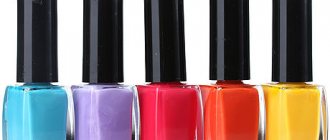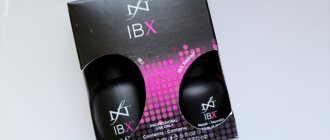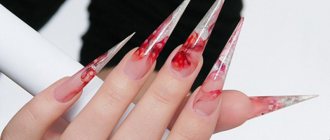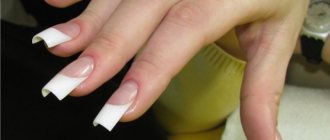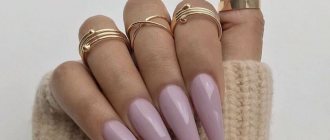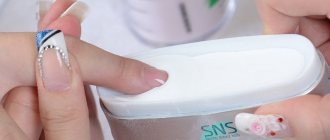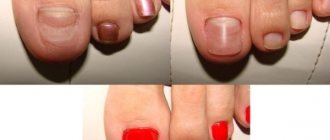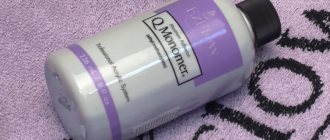Golden measure
Our hands are exposed to total stress every day. Here you have to clean the apartment, and wash the dishes (and without modern “chemistry” - an unthinkable task by today’s standards), and just tapping on the computer keyboard... Hence the brittleness of nails, delamination and porosity. What a long manicure this is! An excellent solution is artificial nails. But what is the best gel to choose for nail extensions? Let's make a reservation right away: if you can do without it, if your nails are good and strong enough, then it is better not to resort to such services.
First there was acrylic
Strange as it may sound in relation to the aesthetics of nails, the primary basis for acrylic artificial manicure was dental practice: the basis for filling teeth was the same acrylic powder mass, which, in combination with a solution, turned into a substance that quickly hardened in air.
A form or tip is placed under the nail, and a single-phase extension gel is applied on top, then the acrylic hardens, the form is removed (the tips remain), and a beautiful and durable nail is obtained.
The challenge when working with this material is speed. Only an experienced manicurist can perfectly evenly distribute the global gel for extensions over the surface of the nail before it hardens, so tips are often used for extensions - and then the finished nail turns out to be denser than when using templates that require special skill. By the way, a good specialist does nail extensions with gel polish in 1.5-2 hours.
Pros:
Acrylic forms a smooth surface and hides defects on deformed nails well.
Minuses:
First of all, there is an unpleasant acidic smell. Both the master and the client suffer. Acrylic coating is not elastic: under increased mechanical load it can simply burst. The same applies to sudden temperature changes. In addition, after removing the varnish, the acrylic base loses its shine.
Nail extensions: which is better acrylic or gel?
If you are a professional manicurist and nail designer, but have not yet tried both popular directions - acrylic and gel extensions - you are probably wondering which approach is better. Let's try to figure out what the difference is between gel and acrylic.
It should be noted right away that a comparison in the spirit of “Which is better?” initially it’s not entirely correct, the gel and acrylic systems are simply different. And who likes what is an individual question.
Both systems use polymers.
Acrylic was invented earlier, and on its basis a gel for nail extension was developed. Acrylic extension system
| Initially, to create acrylic nails, masters used materials borrowed from dentists, but later this trend began to develop independently. At first, the composition included ethyl methacrylate, which was later recognized as toxic and banned in 1974. This element was replaced with a more “humane” ethyl methacrylate. This polymer no longer harmed the nail plate and did not harm the health of the artist who constantly worked with acrylic extensions. Subsequently, the technology improved and became safer and more “obedient” in operation. The original hard and inflexible acrylates have gone into oblivion and now acrylic nail extensions are a beautiful look and protection of natural nails from the effects of the external environment. |
| The only disadvantage of the acrylic system is that the nails are first subject to filing, that is, mechanical removal of the thin top layer. Due to this nuance, acrylic extensions are not suitable for those young ladies who naturally have very thin nails. Acrylic extensions occur according to the following scheme: moistening the brush with liquid monomer (liquid), adding special powder to the brush and modeling the nail using a form or tip. These nails harden in the air. Acrylic nails are considered the most durable today. They do not break even with significant bending and do not crack. This type of extension is suitable for women who lead an active lifestyle and often break their own nails. Acrylic nails are removed after a bath in a special solution. |
Gel extensions
The next generation of nail extension materials is gel. It is also a polymer with which the nail is formed (like acrylic, on forms or tips).
The peculiarity of gel extensions is that the possibility of an allergic reaction on the skin around the nails is practically excluded, which acrylic nails do not guarantee. In addition, the gel is acid-free, so it is chemically completely safe for natural nails.
When modeling nails with gel, the “native” nails are not cut off, which is why gel extensions are considered less traumatic compared to acrylic ones. However, this is not entirely true, because gel nails can only be removed with sawdust.
If we consider the question of which is stronger, acrylic or gel, then acrylic wins. Gel nails are more fragile and can easily crack or break off the tip.
However, gel nails also have a positive effect on the nails. They level the surface of the nail plate. The risk of fungal diseases is also eliminated, since an ultraviolet lamp is used for hardening, and, as is known, UV rays have a disinfecting effect.
Summarize
So, now you can conclude for yourself which is safer: gel or acrylic. Both systems use such advanced materials that there is no need to talk about harm to health. We can only compare the comfort when modeling nails, the duration of wear and the ease or difficulty of removal. But to say that gel or acrylic is more harmful is, in principle, wrong!
Copyright © “FRENCHnails.ru” 2014 All rights reserved. It is strictly prohibited to copy, distribute, publish or modify any type of information without direct reference to the source.
Gel base
Nails are extended using forms and tips. The process is reminiscent of acrylic nail extensions. The only difference is that the jelly nail extension gel becomes hard under the influence of a UV lamp.
Pros:
The main advantage: in their structure, gel nails look like natural ones, they are elastic, and have shine. And no smell! Recently, a huge number of colored, or permanent, varieties of this material have appeared, sometimes not even requiring varnish. The master knows which gel for nail extension is best for you, and if he makes a mistake when decorating a gel nail, the mistake can be corrected immediately: erase it and apply a new design.
Cons: Gel manicure is slightly more expensive than the acrylic version. It cannot be dissolved like acrylic nails, and it cannot be easily repaired either - the defect must be cut off.
Types of nail extensions: simulated nail plate
To model the nail plate, special materials are used: gels, acrylic powders, fabric glass and biogels. To form an artificial nail plate, special paper templates or tips can be used. Types of nail extensions on templates are suitable for those who have a small overgrown tip under which they can place forms. For short nail plates, extensions using tips are used.
Advantages of modeled nails:
- Long-lasting and effective manicure.
- Convenience of working with modeling material, from which you can make a nail plate of any length and shape.
- The resulting nail is no different from the natural one and is a continuation of your nail plate.
- Although the prices for these types of nail extensions are rather high, it is possible to strengthen weakened nail plates.
Disadvantages of nails made from modeling materials:
- The cost of such an extension is quite high.
- Extended nails need to be regularly updated and their shape adjusted.
- There are certain contraindications for such extensions.
Autumn palette
The most fashionable nail polish color for the spring-summer season is gray. In different variations: shades of this tone can be made in both pastel and metallic palettes.
Also in favor are coral, fiery red, cherry, brick, and brown. A manicure made in all shades of blue and purple will look extravagant. Fashionable black a couple of seasons ago (then on short nails) is also acceptable, only more dangerous - you should approach the choice of shape carefully. A calmer, pastel sound in beige, light pink and yellow tones is also relevant - as a kind of nostalgia for summer.
Nowadays you can even fantasize with patterns or create appliqués on your nails. In moderation, of course. You can also do an asymmetrical manicure, placing emphasis on, say, the ring finger. Even decorating a manicure with Swarovski rhinestones has become a sign of good taste!
Lunar sketches in the French style
Particular attention is paid to the so-called “moon jacket”... This type of manicure has nothing to do with the Earth’s satellite. It's all about that part of the nail that is located at its base, in other words, the hole. In French manicure, it now takes pride of place, standing out against the general background with the same color as the rim of the nail. For example, in a combination of red and white, brown and beige, purple and pink...
It is worth noting
You can determine whether it is better to extend your nails with gel or acrylic based on your desires. If you want shiny nails that highlight the natural color, then gel is suitable. French manicure looks great with it. And for those who want an incredible design, three-dimensional elements are acrylic. It allows you to create any design, even a fantasy one.
Nowadays people no longer wonder whether nail extensions are harmful, because modern materials are almost completely harmless, especially if a nail technician works. Do not attempt to remove gel nails yourself, as infection can easily occur if you do not have sterile equipment.
Only incorrect nail removal can be harmful. In the case of gel, the nails are filed down - this is a long process that must be done very carefully. It is easy to damage the nail or get an infection here. Acrylic nails are easier to remove and do not require mechanical filing. If you don’t know this, you can fiddle with hard acrylic for a very long time, breaking your natural nail.
In any case, contact a trusted nail technician who will be able to find an approach to your nails, help maintain their health and beauty, and highlight them with a stylish design. Extensions will help those whose nails are naturally brittle and do not grow long enough. Whether it is better to extend your nails with gel or acrylic, you will understand only when you try extensions.
Harm or benefit?
Gel manicure will not affect the texture of the nail in any way. Frequent mechanical treatment thins the upper part of the nail plate. In addition, false nails create a so-called “greenhouse effect” for natural nails. As for time restrictions, artificial manicure can be used for years: it causes zero harm to nails. With an indispensable condition: nails must be healthy.
Taboo: gel nails are not recommended if there is damage to the nail matrix and in the presence of fungal diseases. It is fraught with irreversible consequences.
The cost of services from an experienced master in a famous salon will be higher than from someone who has completed a week-long course. True, the crisis has made its own adjustments here: prices for gel nail extensions, even in prestigious salons, have fallen by about 20 percent. Acrylic manicure is less popular, and the source material itself is cheaper. Hence the lower price. Getting a classic manicure costs about half as much. But even the most spoiled white-haired girl won’t be able to go through a month with just one polish. A self-respecting lady visits the salon for this procedure, say, once every 3-4 days. Hence the conclusion: there is practically no difference in price compared to false manicure, and in terms of time it is much more tedious.
Which is better: acrylic or gel for nail extensions? was last modified: January 30, 2021 by Gulya
Cons of the gel
Gel is not the best option for winter. The clear answer to the question of which nail extension is better in the cold season – acrylic or gel – is definitely acrylic. The gel may not perform well during sudden temperature changes. First, it gives numerous microcracks and fades, and then becomes covered with quite noticeable and fairly large cracks. But there are a number of features that make wearing the gel difficult even in summer.
- The plates turn out to be quite thick and look unnatural. With subsequent corrections, the layer constantly increases and it has to be cut off with a cutter from the bottom of the nail;
- Once broken, they are practically irreparable. You have to remove the entire nail and build it up again. This affects not only the cost of the procedure, but also its duration;
- Compared to acrylic nails, such nails are more fragile;
- The gel is removed by filing. This makes the procedure long and unpleasant. In addition, there is a possibility of damage to your own nail plate.
When choosing acrylic or gel nail extensions, many are guided not only by which is better, but also by the financial component of the issue. Those who want to save money are recommended to extend their nails with acrylic. Most often, correction of gel extensions costs much more.
https://youtu.be/HVETYFF-lTg
[yandex3] [google3]
